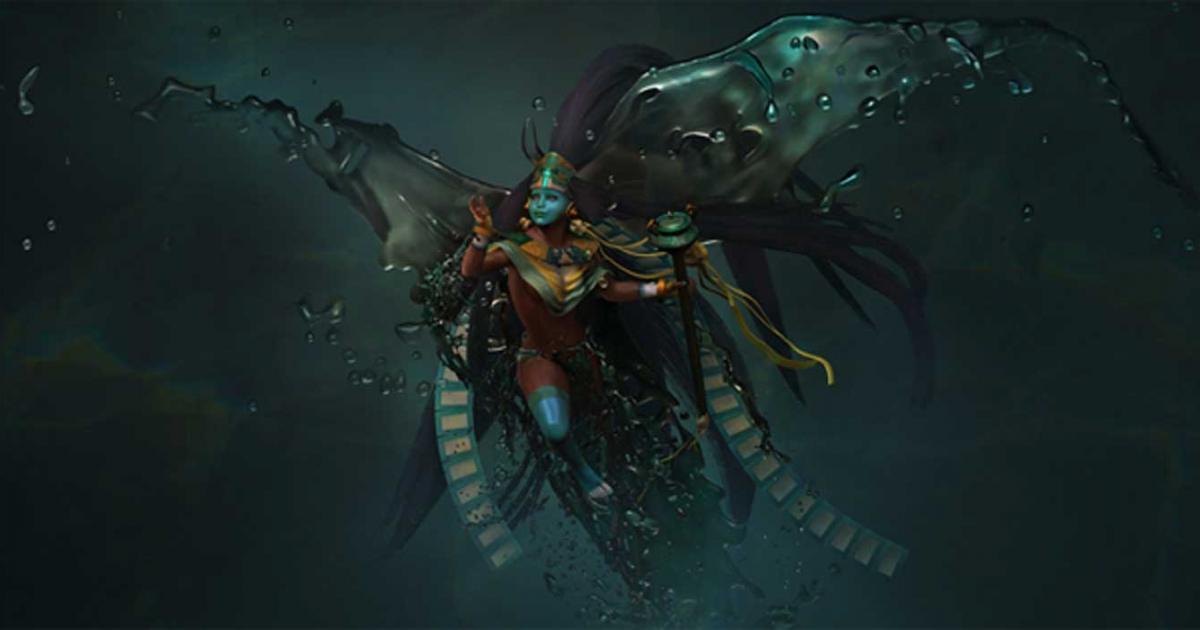
Navigating the Realm of an Aztec Water Goddess and One of the Five Suns
The Aztecs placed an array of important life elements in the hands of Chalchiuhtlicue. She was primarily a goddess of freshwater, thus her domain included lakes, rivers, and streams. But she also became the patroness of navigation and was believed to have been the protector of women in labor and their new-born babies.
Goddess in a Jade Skirt
The name ‘Chalchiuhtlicue’ may be translated as ‘She who Wears a Jade Skirt’, and this Aztec goddess was known also as Matlalcueya (which means ‘She who Wears a Green Skirt’).
Although Chalchiuhtlicue was in charge of fresh water bodies, such as lakes, lagoons, streams, and rivers, the Aztecs assigned the responsibility over salt water bodies to a separate deity, Huixtocihuatl (which means ‘Salt Lady’).
Not much is known about Chalchiuhtlicue’s relationship with the other gods of the Aztec pantheon, apart from her connection with Tlaloc, the rain god. Even so, it is unclear as to how these two deities were associated. According to some, Chalchiuhtlicue and Tlaloc were a married couple, whilst others believe that they were siblings. Yet others are of the opinion that the two deities were one and the same, though in separate guises.
- Aztec Leaders: Rulers, Supreme Ruler and the Voice of the People
- Xolotl – The Underworld Dog God of the Aztecs
- Xipe Totec: This Gory God Shows the Unique Way Aztecs Viewed Fertility and Renewal

Tlaloc in the Codex Rios. (Public Domain)
Chalchiuhtlicue: Goddess of Creation and Destruction
As a goddess of water, Chalchiuhtlicue had both life-giving and destructive aspects. Water was an essential element in any civilization that relied on agriculture, and the Aztecs believed it was she who brought the waters needed for the irrigation canals that transported this precious resource to the fields where maize was grown.
When angered, however, Chalchiuhtlicue could punish human beings by withholding the irrigation waters, and cause droughts, which would result in the failure of crops. In this agricultural role of hers, the Aztec freshwater goddess is commonly associated with Chicomecoatl (known also as Xilonen), a corn goddess.

Relief with Maize Goddess (Chicomecóatl). (Brooklyn Museum)
Protecting Mothers, Babies, and Fishermen
Although primarily associated with the fertility of the land, Chalchiuhtlicue was somehow connected with human fertility as well, as she was considered to be a goddess who protected women undergoing the pangs of childbirth, as well as new-born children.

A drawing of Chalchiuhtlicue, one of the deities described in the Codex Borgia. (Public Domain)
Apart from that, her protection also extended to fishermen, and she was also considered the patron goddess of navigators. This is reasonable, considering that those belonging to these two trades needed to venture into her domain for their livelihood and were completely at her mercy. The Aztec goddess could protect them, and aid their work, though when upset, she had the power to create whirlpools and storms that could make it extremely dangerous for the fishermen and navigators.

Stone sculpture representing goddess Chalchiuhtlicue. (Luis García/CC BY SA 3.0)
Her Role in the Myth of the Five Suns
The most destructive aspect of Chalchiuhtlicue, however, is seen in the Aztec myth of the Five Suns, which is about the creation of the world. In this myth, the gods had created and destroyed the world four times, and the current world we live in is in fact their 5th creation. In this myth, after the third earth was destroyed by Tlaloc, who sent a downpour of fire to burn away all creation, a new earth was created, with Chalchiuhtlicue serving as the Sun.
- The Infamous Eagle Warriors: Elite Infantrymen of the Aztec Empire
- Cuauhtémoc, The Last Aztec Emperor to Fight Against the Spanish
- The Monolith of Tlaloc: Did Moving This Massive Stone Statue Incite the Fury of the Aztec Rain God?
According to one account of the myth, the gods Quetzalcoatl and Tezcatlipoca became jealous of the water goddess and struck her down from the sky. As a consequence, the world was destroyed by a flood, and the people of that age were turned into fish.
Numerous depictions of Chalchiuhtlicue have survived to this day and they are found in museums around the world. In addition to paintings of her in codices, there are quite a number of sculptures that have been identified as her. These statues have a distinct headdress, which is a wide headband with large ear tassels hanging from them. The statues are commonly found in one of two poses, i.e. standing or kneeling.

Chalchiuhtlicue statue. (JPG/CC BY SA 4.0)
Top Image: Chalchiuhtlicue final model. Source: MG2G
By Wu Mingren
References
collections.artsmia.org. 2018. Chalchiuhtlicue, c. 1200-1521. Available at: https://collections.artsmia.org/art/104485/chalchiuhtlicue-aztec
Holloway, A. 2013. Aztec Creation myths. Available at: https://www.ancient-origins.net/human-origins-folklore/aztec-creation-myths-0071
Jessica S. 2014. Chalchiuhtlicue, the Aztec Goddess of Water.
Available at: https://www.journeymexico.com/blog/chalchiuhtlicue-the-aztec-goddess-of-water-mexico-journey
Maestri, N. 2017. Chalchiuhtlicue - Aztec Goddess of Lakes, Streams, and Oceans.
Available at: https://www.thoughtco.com/chalchiuhtlicue-goddess-170327
The British Museum. 2018. figure. Available at: http://www.britishmuseum.org/research/collection_online/collection_object_details.aspx?objectId=669692&partId=1&images=true
The Editors of Encyclopaedia Britannica. 2007. Chalchiuhtlicue. Available at: https://www.britannica.com/topic/Chalchiuhtlicue
The Metropolitan Museum of Art. 2018. Water Deity (Chalchiuhtlicue). Available at: https://www.metmuseum.org/art/collection/search/307651
Took, T. 2013. Chalchiuhtlicue. Available at: http://www.thaliatook.com/AMGG/chalchiuhtlicue.php
















Comments
Another excellent article with fantastic references. The scope of your interests are extraordinary